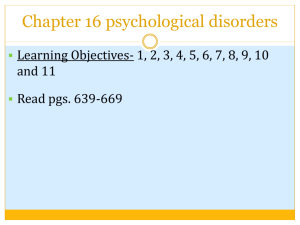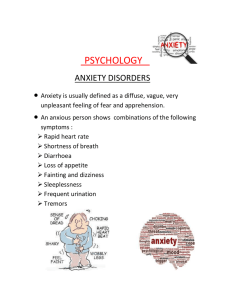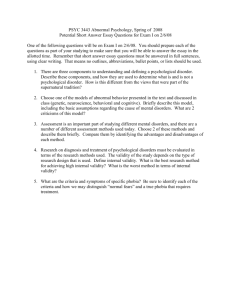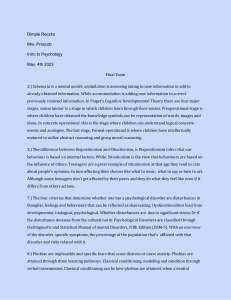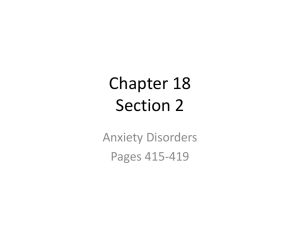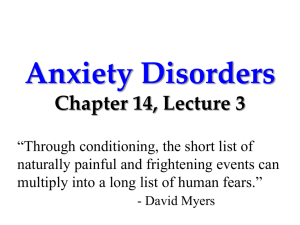17.SpecificDisorders..
advertisement
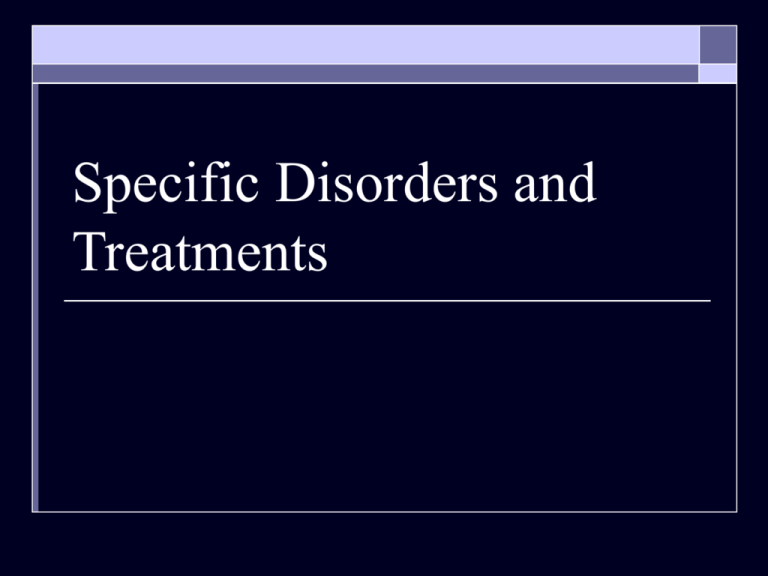
Specific Disorders and Treatments Three most commonly diagnosed psychological disorders Anxiety Disorders / Substance Abuse / Depression Psychological disorders are behaviors or mental processes that are connected with various kinds of distress or disability. Lifetime prevalence of psychological disorders Anxiety Disorders Anxiety… is fear and caution in the face of potential hazards is an appropriate response to a real threat is considered pathological when it interferes with daily functioning Anxiety has psychological and physical features. Psychological features such as worrying, fear of losing control, inability to relax Physical features such as pounding heart, faintness, trembling A combination of vulnerability and stress may produce psychological problems. The top bar shows low vulnerability and low stress. The result? No problem. The same is true of the second bar, where low vulnerability is combined with moderate stress. Even high vulnerability (third bar) may not lead to problems if stress levels remain low. However, when high vulnerability combines with moderate or high stress (bottom two bars) the person “crosses the line” and suffers from psychopathology. Types of disorders Generalized anxiety disorder (GAD) is the experience of almost constant and exaggerated worry. There is no basis for the worries but the person is tense, irritable and tired. About 5% of the general population will experience GAD. Panic disorder (PD) is an abrupt attack of acute anxiety that is not triggered by a specific object or situation. They involve rapid breathing (hyperventilation), increased heart rate, chest pains, and sweating Sometimes the person’s subjective interpretation of the symptoms of hyperventilation can cause an increase in panic. Phobias Phobia are excessive, irrational fears of specific objects or situations, such as snakes or heights. Prevalence = About 11% of U.S. adults suffer from a phobia at some point in their lives. About 5-6% are experiencing a phobia at any given time. Some common phobias include: Agoraphobia = open spaces Claustrophobia = closed spaces Acrophobia = heights Misophobia = germs Acquiring Phobias Some fears are innate but many are learned. Some phobias can be traced to a specific event. Therapy for Phobias Behavior therapy for phobias Systematic desensitization – reduces fear by gradually exposing people to the object under controlled conditions. Virtual reality is now being employed for this kind of therapy. Flooding or implosion – a sudden and large-scale exposure to the object under controlled conditions. http://youtube.com/watch?v=3ppm2lhpkXs (1:50) http://youtube.com/watch?v=CjvbFb3QW64 (1:21) Posttraumatic stress disorder (PTSD) is characterized by feelings of anxiety and helplessness that are caused by a traumatic experience. The traumatic event is revisited in the form of intrusive memories, recurrent dreams, and flashbacks. Substance Abuse Individuals who find it difficult or impossible to quit a dangerous habit are said to have an addiction to it or a dependence on it. There are two symptoms involved in the development of a drug addiction. Tolerance – decreased effects of a given dose. Withdrawal – unpleasant sensations when the drug is not used Substance Abuse Alcoholism Alcoholism is defined as the habitual overuse of alcohol. Both genetics and culture have an influence on alcoholism Treatment includes Detoxification programs, Alcoholic Anonymous (AA) Only 10-20% are successful and relapses are very common. Mood Disorders Depression Characterized by long periods of sadness, little interest in anything including food and sex, sleep abnormalities, feelings of worthlessness Events that precipitate depression including severe losses in life, lack of social support, FYI - It is not just the event but also the person’s interpretation of the event’s significance that influences the degree of depression. Seasonal affective disorder (SAD) Most people feel slightly better during the summer (when the sun is out most of the day) than during the winter (when there are fewer hours of sunlight). Seasonal affective disorder is commonest in far northern locations where the summer days are very long and bright and the winter days are very short and dark. The disorder is unheard-of in tropical locations such as Hawaii, where the amount of sunlight per day varies only slightly between summer and winter.
